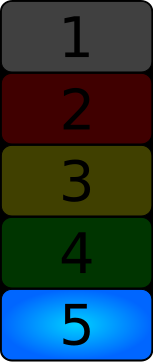A few origin stories for some miserable things we’ve all heard of:
MISERY INDEXES
Here’s a look at some famous and not-so-famous indexes
that are used to measure the bad things in life.THE SAFFIR-SIMPSON HURRICANE SCALE
Background: Robert Simpson was the head of the National Hurricane Center in August 1969 when Hurricane Camille—one of the most powerful hurricanes ever to hit the United States—bore down on the Gulf Coast states. New forecasting tools had enabled the Center to predict Camille’s intensity, and Simpson raised such an alarm that more than 81,000 people evacuated the affected areas. Result: Fewer than 300 people were killed when it hit. Nonetheless, Simpson felt that a more effective way of communicating the size and likely impact of a hurricane was needed. So he contacted Florida engineer Herbert Saffir, who had recently devised a five-category windstorm scale for the United Nations to predict how much damage would be caused to structures hit by winds of various strengths. Simpson and Saffir worked to incorporate potential damage from storm surges and flooding intro hurricane predictions; their Saffir-Simpson Hurricane Scale made its debut in 1971.
How It Works: Hurricanes are classified into five categories according to wind speed: Category 1 (74–95 mph), Category 2 (96–110 mph), Category 3 (111–130 mph), Category 4 (131–155 mph), and Category 5 (156 mph and greater).
Details: The scale has proven ineffective at predicting flooding and the height of storm surges. Both vary too much according to local factors such as the shape of the coastline and slope of the continental shelf where the hurricane makes landfall. In 2010 these elements were removed; now it’s solely a wind scale.DEFCON
Background: If you’re a fan of science fiction or war movies, you may already know that DEFCON is short for “Defense Readiness Condition” and is measured on a scale from 1 to 5. The system was created in the late 1950s to give all U.S. military operations worldwide a simple measure of the nation’s current state of alert.
How It Works: DEFCON 5 is the lowest level of readiness in peacetime. As perceived threats increase, the military’s readiness can be raised in stages all the way to DEFCON 1, when war is imminent. (Precise details of how the military increases its readiness when the DEFCON level is raised are kept secret.)
Details: Are you old enough to remember the Cuban Missile Crisis in 1962? Throughout much of the Cold War the military was kept at DEFCON 4, but during the Cuban Missile Crisis the alert level was raised to DEFCON 3, and the U.S. Air Force’s Strategic Air Command was ordered to DEFCON 2. That’s the only time since the creation of the system that any part of the military has been placed at DEFCON 2. During the 9/11 attacks the alert level never rose above DEFCON 3. DEFCON 1 has never been used.THE DOOMSDAY CLOCK
Background: By the summer of 1947, just two years after the atomic bombing of Hiroshima and Nagasaki, the directors of the University of Chicago’s Bulletin of Atomic Scientists had grown so concerned about the possibility of another nuclear war that they created a symbolic clock face called the “Doomsday Clock” to convey their estimation of how close the world was to “midnight”—nuclear Armageddon—at any point in time. The clock has appeared on the cover of the Bulletin ever since.
How It Works: When the clock was created in June 1947, it was set at seven minutes to midnight. Between 1947 and 2011, the minute hand was moved 19 times, closer to midnight when the Bulletin’s board of directors thought the danger of nuclear war was increasing; farther from midnight when the danger was receding.
Details: When the U.S. and the Soviet Union both tested hydrogen bombs in 1953, the clock was reset from three minutes to just two minutes before midnight, the closest to the zero hour that it has ever been set. The farthest it has ever been from midnight was in 1991, when the end of the Cold War and the signing of the first Strategic Arms Reduction Treaty prompted the editors to move it from 10 minutes to 17 minutes ’til midnight in a single stroke. In 2007 the clock was updated to include non-nuclear dangers such as biological weapons and climate change. (So what time is it now? As of December 2011, it’s six minutes to midnight.)
That’s another in our series of article excerpts from the brand new Uncle John’s 24-KARAT GOLD Bathroom Reader. Read about more misery indexes, and hundreds of other stories – at 30% off the usual price as part of our annual HOLIDAY SALE.
[pic]
• Past excerpts can be found by hitting “Excerpts” in the tags blow this post.









